Understanding the condition of your cards
In the world of trading cards, the condition is everything. You have a shadowless Charizard? I don’t care. Oh, it’s in mint condition? Now, I’m listening.
Here’s the basic condition scale that is widely used by collectors and graders:
- Near mint
- Lightly played
- Moderately played
- Heavily played
- Poor
- Damaged
Each grading service is going to have its own guidelines posted on its website, explaining exactly what each of these means. Here are a few:
If you’re hoping for a 9 or better, you’d better select cards that are in the ‘near mint’ category. This means that they are almost void of any defects and appear to be in almost perfect condition, or better.
Damage to look for when pre-grading your cards
You’ll want to hold your card under good lighting and even have a magnifying glass nearby if you think it will help. You’ll be looking for a list of damage and potential defects, such as:
- Scratches
- Creases
- Dings
- Dents
- Nicks
- Ink spots
- Edge wear
- Whitening
- Delamination
- Peeling
- Chipping
- Corner wear
- Edge fraying
Of course, if the card was freshly pulled from a booster pack, you can spend less time checking it for damage. Sometimes cards can still receive damage from the factory, but this is rare. If your card is pack fresh, you can probably consider it near mint.
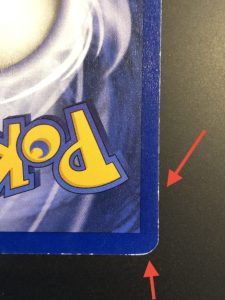
Unfortunately, if you find any of the above, your card runs a risk of not receiving a high grade. Specifically, if your card has damage such as a crease or dent, it will automatically be dropped to a lower grade.
Pre-grading your cards
Be Subjective When Pre-Grading
It’s almost time to pre-grade, but first, you’ll need to understand one very important thing: be subjective.
Subjectivity is the backbone of grading cards. This means that you can have no bias toward the card you’re examining. To you, it should make no difference if it’s a Caterpie or 1st edition Charizard when it comes to the grading scale.
If you can be honest and acknowledge any damage or defects you see, your pre-grade will be more accurate.
Subgrades
Some card grading companies such as Beckett, offer subgrades on the label. This is a nice way of offering transparency to the customer, and showing right on the label which categories brought the card grade down.
Unfortunately, not all grading services offer sub-grades upon the label, but hey, you have the choice of which service you use.
Even if the service doesn’t offer subgrades on the label, they still grade your cards based on those 4 categories:
- Corners
- Edges
- Surface
- Centering
Let’s break each one of these down so you’ll know what to look for.
Corners
Corner Damage
Pokémon cards have rounded corners (with the exception of TOPPS cards), which is a blessing, believe me. But corners are still highly sensitive to all kinds of mishandling.
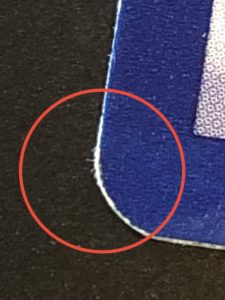
The worst offender is probably the action of inserting cards into binder pockets, sleeves, and top loaders. This can lead to small dings and potential edge fraying. In some cases, this can cause chipping of the face or rear surface.
Factory Cuts
Unfortunately, the damage isn’t the only factor when it comes to corners.
During the recent explosion in Pokémon card popularity, the card quality has suffered. Demand was through the roof and the manufacturers had to print cards faster and in much higher quantities.
This resulted in corners looking like they were chopped rather than cut. Some corners are coming from the factory looking more like a stop sign than a curve.
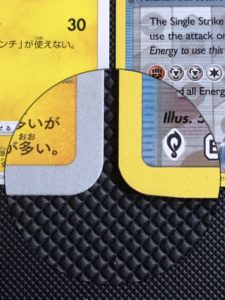
Anyways, this is something to look for. Grading companies are checking to see if the card’s corners are rounded nicely. The good news is that the more expensive Pokémon cards seem to be less susceptible to this problem, and often have the nice corners we want.
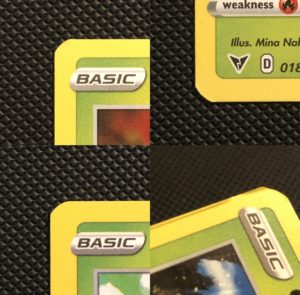
Edges
This one is a little self-explanatory, but there are some nuances.
Graders are looking for fraying, in most cases. Again, this mostly happens from handling the card too much. Frequently inserting it into different vehicles for protection/storage can ironically lead to worn edges over time.
Also, never tap your cards against a surface to straighten out a stack. Don’t.
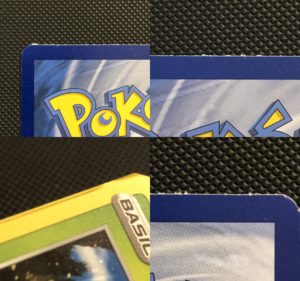
Edges can come from the factory with some pretty bad fraying already. Again, this has become a problem only recently but isn’t seen on high-end cards as often. Some collectors claim they can trim the burrs off with a sharp razor blade, but I wouldn’t recommend this.
You’ll want to take a look at the edge from the side as well. If you have good eyes or a zoom function on your camera, you can see the layers of cardstock that the card is made of. A quick check to confirm that everything looks normal is recommended.
The layers of the card can, in some cases, have defects or begin to separate. This is usually pretty noticeable, but worth mentioning.
Surface
When the grader is going over the surface of the card, they’re looking for any damage or defects that can usually be seen by manipulating the card under a light. By moving the card and using the glare, you can pick out very small scratches and dents that are impossible to see head-on.
The surface damage I most often see is small vertical scratches. These probably come from sorting, when you have a stack of cards in one hand, and slide the front card off with your opposing thumb. Holos are especially susceptible to this.
Another culprit is actually card sleeves. Holding the sleeve with your thumb and index finger resting on the front and back will apply slight pressure to the front and back surfaces of the card when sliding it in. This is usually harmless, but in some cases, the sleeves could be dirty. I recommend always using fresh sleeves.
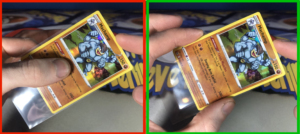
Non-Holos
If you happen to be grading a non-holo card, this subcategory is your friend.
Most surface damage happens to holofoil cards since the foil is delicate. But non-holos (this also includes the rear of a card) are a little more resilient and won’t damage as easily. Still, damage can happen, so you’ll need to check over every inch.
Holos
As previously stated, holo surfaces are much more likely to acquire scratches or scuffs. This is the number one offender when your grade suffers from surface damage.
The more holo showing, the more delicate the surface is going to be. Cards with a holo pattern across the full face are going to be the worst. Take your time here and pay close attention. Move the card in the light to see better.
Holos With Texture
Many modern Pokémon cards have textured surfaces now. This is super cool to hold, feel, and look at, but a pain in the butt when pre-grading.
The texture can sometimes be incomplete. It is often designed with many small lines, resembling something of an alien fingerprint pattern. Check closely, following the flow of the textured lines, and look for any breaks that look out of place.
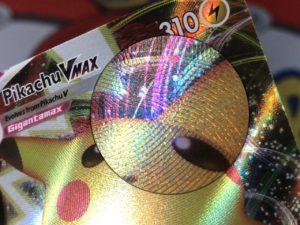
I’ve yet to confirm this but I believe that the texture is added to the card by applying pressure, such as a press. This would make sense since we’ve seen spots missing the texture as if obstructed.
Centering
The final subcategory is centering. This is simply how well the card image is centered on the physical 2.5X3.5 piece of cardstock. Both the top and sides are taken into consideration, as well as both the face and rear of the card.
It might take some practice, but you’ll learn to quickly spot bad centering. If the card has the solid yellow border that so many Pokémon cards do, it will be easier.
But many cards do not have a yellow border. Sometimes the border is a different color, and sometimes most of it is missing altogether.
If the card’s centering is bad, it will lose points on the grade.
How Bad Can Centering Be And Still Get A 10?
Thankfully, most grading companies offer a little bit of leeway when it comes to centering. It depends on the service you choose, but most will consider a 60/40 split to still be a 10 (such as PSA).
However, the harsher grading services will require absolutely perfect 50/50 centering for their perfect 10 grades, such as Beckett’s legendary black label 10.
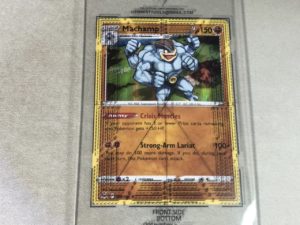
It can be helpful to use a centering tool. This is a very inexpensive lens that you place over your card, line up the points, and it will show you exactly how accurate the centering of your card is. Here is a link to Amazon if you want to check it out.
Choosing A Final Grade
So now you know the basics of pre-grading your card. But the question is, how do you pick a number?
The truth is, every card is unique and the difference between a 9 and a 10 is, in some cases, nonexistent. For example, if your card is near mint but has just one or maybe two small imperfections, it might get a 9. Heck, it might get an 8.
That is the nature of sending your cards in for grading. Something you can do it better understand grades is to get more familiar with them.
You can head over to the PSA website and look at cards. Even better, check out eBay and spend some time studying various graded card listings. See if you can pick out why each got received the grade it did.
Eventually, you’ll become familiar with how the company grades and what grade a card is likely to receive.
Preparing your cards for submission
Most of these grading services are going to be very picky about how to package your cards to be submitted.
There are several guidelines that grading services typically recommend when it comes to packaging cards for shipping. These guidelines may include using a protective case like semi-rigid sleeves and standard sleeves for the card, using a sturdy cardboard backing or top loader, and using bubble wrap or other cushioning material to provide extra protection. It is also a good idea to use a sturdy box and plenty of packing material to prevent the item from moving around during transit.
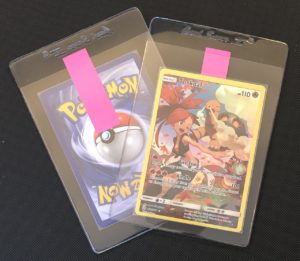
Grading services may also have specific requirements for how items should be packaged and shipped. For example, they may require that items be shipped with a tracking number or signature confirmation to ensure that they can be traced and delivered safely. It is always a good idea to check the specific guidelines of the grading service you are using to make sure you are following their requirements.
Here are some shipping guidelines from a few grading companies:
Should You Clean Your Cards Before Grading?
The short answer is no. Cleaning a card will often cause more damage and should be avoided. But the graders will not clean the card either, so in some cases, it can be beneficial.
To expand on that, some cards are susceptible to fingerprints (TOPPS Chrome!!) and your card’s grade will definitely suffer if it’s sent in with a fat thumbprint on it.
In this case, very careful removal of the fingerprint with a microfiber cloth is necessary.
I have a guide on cleaning Pokémon cards, but if a card is so dirty that it needs to be scrubbed, then it’s just never going to get a good grade anyway.
Factors You Cannot Control
Understand that you can pick out the best-looking card in your collection, worthy of a perfect 10, and have it receive a lesser grade. There are factors you can’t control and defects you sometimes can’t see.
For example, some graders will incorporate the use of a VSC machine into the card’s examination. This is a high-end forensic-level piece of equipment used for the examination of documents and in our case, trading cards.
This machine goes beyond what the human eye can detect, using multiple light sources and spectrums to detect defects.
With this in mind, you can never be sure that a card will receive the grade you think it is going to receive. This is a factor you just cannot control, so go easy on yourself if your card didn’t score the 10 you hoped for.
Conclusion
I consider pre-grading a necessary step in the grading process. I can’t tell you how many times I’ve gone to pre-grade a card, only to find way more damage than I anticipated.
Not only does it save you from sending in damaged cards, but pre-grading is an amazing method to sharpen your skills. If you practice enough, you’ll eventually spot patterns and become a better collector.

Hi, I'm Oliver. I've been collecting Pokémon cards for 25+ years. I hope you enjoyed your read and learned something. Learn more about me on the About page.

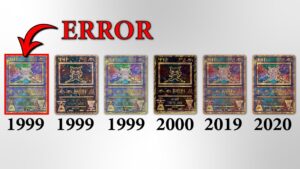

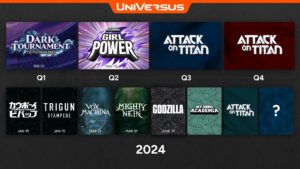
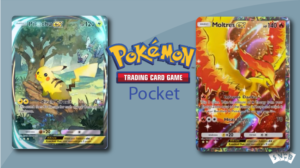
2 thoughts on “How To Pre Grade Pokémon Cards (Beginner’s Guide)”
excellent advice, thank you. my son and I will practice pre grading tonight
Thanks!